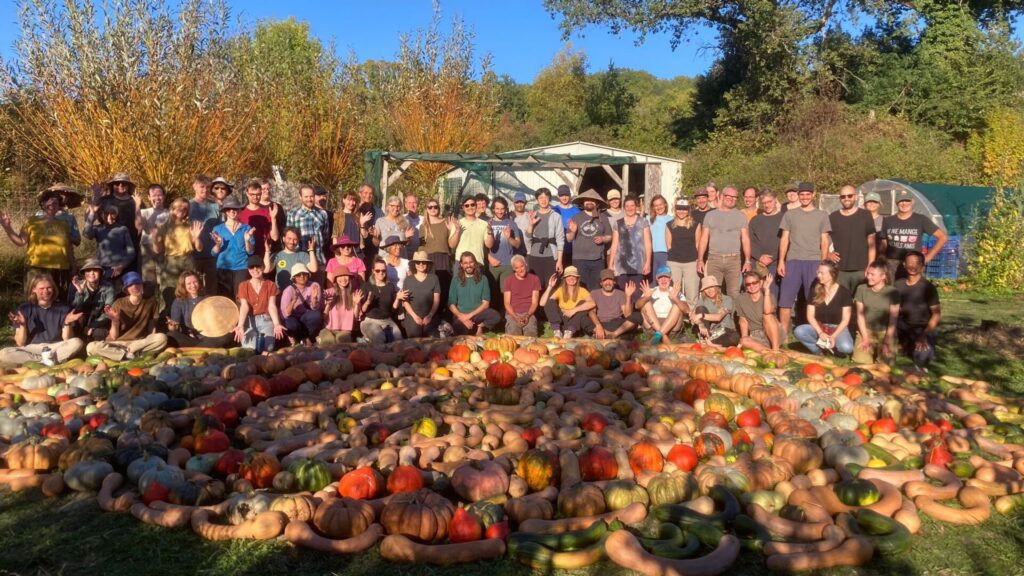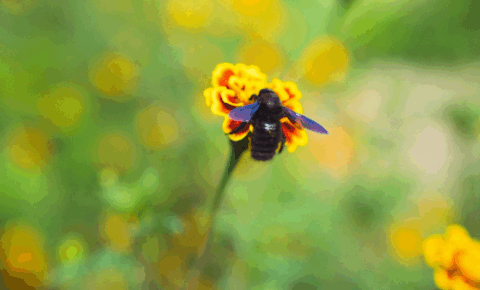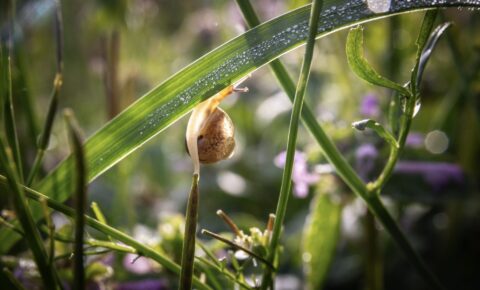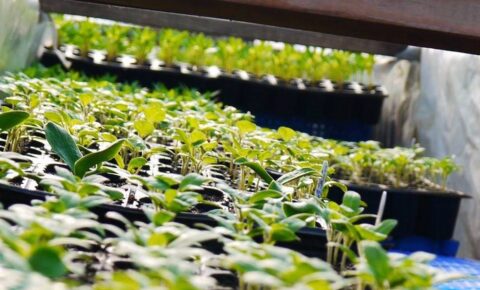Mick McEvoy of the Plum Village Happy Farm and Rewilding Project shares his insights and offers simple, nourishing practices and reflections inspired by the autumn to help care for one’s well-being, and touch the insight of interbeing between people, plants, all beings, and the Earth.

The Annual Cycle of Birth and Death
With autumn’s arrival, I will spend as much time as possible outdoors on the Happy Farm and our Plum Village Rewilding project, connected to Earth, forest, and soil. In this season, the reality of interbeing is inescapable in the natural world.
My friend Zachiah Murray, in their wonderful book Mindfulness in the Garden, wrote this beautiful poem (or gatha) that looks deeply into the reality of interbeing of all life in the garden. I recite it often as I step over the sacred threshold of the Happy Farm, especially in this season of autumn:
Entering the garden
I see my true nature.
In its reflection
my heart is at peace.
Autumn on the Happy Farm is a season of descent, a time of year when the energies of life are descending back into the soil, into Earth. All of our big harvests have been completed over the last weeks. Our pumpkins, winter squash, and sweet potatoes have all been harvested with the help of our Happy Farm Harvest Retreat guests in October. The residues of our summer crops have been cleared from the beds and will be composted. Later, they will return their nutrients to the soil to nourish next spring’s crops. This is the universal cycle of farming—each crop cycling back to nourish future harvests for the community. The reality of interbeing is unsurpassed.
Observing this annual cycle of birth and death, harvest and renewal, I see that as a gardener I am part of this cycle of interbeing. I exist within the reality of continuation and play an integral role alongside soil, seeds, sun, rain, pollinating insects, and many other humans offering their hard and loving work. Working in the garden and observing my own nature reflected back to me, I see clearly that I too am of the nature to grow old, to get sick, and to die. One day I will be separated from everyone and everything that I love and treasure. I accept that my actions are my only true belongings; they are the ground on which I stand. Every action of mine in the garden and in life bears my signature and will continue after I die.
In its reflection, my heart is at peace. Observing this deep reflection that my life is deeply entwined with the multitude of life in the garden, my heart is at peace—peace generated from my faith in interbeing, in impermanence, and in continuation.

An Ancient Story of Interbeing
In Plum Village, we are blessed to be surrounded by ancient oak forests. These forests hug the edge of Happy Farm in Upper Hamlet and are peppered throughout the Plum Village Rewilding Project. There is a story of Oak, Jay, and Wild Boar, which is as ancient as these forests themselves.
In autumn, the oaks produce their seeds, their acorns, in abundance. Jay is a beautiful and wise bird that has evolved together with oak, deriving a great deal of nourishment from oak acorns. Wild boar, too, are deeply intelligent beings and the ancient ancestors of all our domesticated farm pigs. In Plum Village, the wild boar sleep throughout daylight hours in great family communities deep in the oak forests. As the sun sets, they awaken, and for them, the day begins. In autumn, these immense families of wild boar collectively forage for oak acorns on the forest floor.
Beyond the relationship of oak feeding jay and wild boar, there are wider threads of mycelial relationships. Wild boar survive by using their strong noses and tusks to open up the soil in the meadows and forest floor to forage for roots, beetles, worms, and other insects. Meanwhile, jay will gather more oak acorns than they can eat and store them away for the winter months. Often, they store them in the pockets of soil excavated by wild boar. They hide the acorns deep in the soil and then return to them in the winter. But jay is benevolent: they will plant more oak acorns in the soil than they need to survive the winter.
As wild boar root around opening up pockets of soil, they act as ecological engineers, agents of regeneration. Equally, jay, as they plant oak acorns in excess of their own needs, acts as a custodian of the forest, manifesting future oak forests for us all. Oak provides enough food for jay and wild boar, ensuring their survival, and in doing so, oak ensures its own continuation. This ancient story of interbeing can be best experienced in the season of autumn by spending time on the land with oak, jay, wild boar, and forest.

The Honourable Harvest
This autumn, the oak forests in Plum Village and the surrounding region have produced an unbelievable abundance of oak acorns. This is what we call a ‘mast year,’ the production of an abundance of seeds by a plant in regional synchrony with other plants of the same species, taking place every few years.
A mast year for oak helps the survival of jay and wild boar but also feeds squirrels and wood mice. Barn owls and kestrels, who feed on wood mice, and pine martens and foxes, who feed on squirrels, also benefit. A mast year in the oak forest ensures the health and vitality of the entire woodland ecosystem.
Woodland ecosystems also include humans. In her pioneering book Braiding Sweetgrass, Robin Wall Kimmerer shares a story about her grandfather, who, as a boy, experienced the gift of a mast year in the pecan nut forest along the Canadian River where he grew up:
How generously the pecan trees shower us with food, literally giving themselves so that we can live. But in giving, their lives are also ensured. Our taking returns benefits to them in the circle of life, making life—the chain of reciprocity. Living by the precepts of the Honourable Harvest—to take only what is given, to use it well, to be grateful for the gift and to reciprocate the gift—is easy in a pecan grove. We reciprocate the gift by taking care of the grove, protecting it from harm, planting seeds so that new pecan groves will shade the prairies, feed the squirrels, and the young boys.
At Happy Farm, as mentioned, the autumn harvest of our sweet potatoes, pumpkins, and winter squash is now complete. Many beds lie empty. As Happy Farmers, we endeavor to practice the Honourable Harvest by cultivating cover crops on these empty beds. Cover crops are grown not for harvest but to offer back nutrition to feed the soil.
As we have cultivated and harvested sweet potatoes, pumpkins, and squash, we have taken a lot of nourishment from the soil and must give back. These winter cover crops—oats, mustard greens, radish, and clover—will germinate on the soil in autumn and begin to grow strongly before winter arrives. They protect the soil from being washed away by heavy winter rains. In spring, they continue to grow, may reach over one metre tall, and flower, offering nectar and pollen to pollinating insects emerging from hibernation. Finally, we lay a thick tarpaulin over these cover crops to return all their biomass to the soil, nourishing the multitude of unseen life within it. We do this with love and reverence, knowing that a healthy soil will continue to feed our community in Plum Village. This is one manifestation of how we practice the Honourable Harvest.

Perhaps many of our ancestors once lived in harmony with the spirit of the Honourable Harvest. Now, in this era of hyper-individualism, oligarchy, and the relentless pursuit of perpetual economic growth, many in our human family constantly extract without reciprocating. This is a factor contributing to the polycrisis we are now experiencing: climate crisis, nature crisis, and social crisis. Aware of the reality of interbeing and Thay’s teaching of “No mud, No Lotus,” I offer the final word to Robin Wall Kimmerer:
Even a wounded world is feeding us. Even a wounded world holds us, giving us moments of wonder and joy. I choose joy over despair. Not because I have my head in the sand, but because joy is what the earth gives me daily and I must return the gift.
Reflective Practices
If you feel called to learn from the wisdom of autumn, here are a few practices you could explore:
Journal, walk, or sit with these questions. Or share them with a good friend—ask each question one by one, and listen deeply to your friend’s response before changing roles:
- Where does interbeing show up in your life?
- How can you cultivate more interbeing in your life, especially with the natural world?
- Which parts of your life are in harmony with the teaching of the Honourable Harvest?
- Which parts are not?
- For the parts of your life that are not aligned with this teaching, how might you realign to come into harmony with the spirit of the Honourable Harvest?







Share Your Reflections